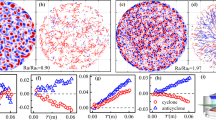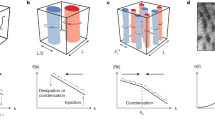Abstract
BECAUSE of its relevance to large-scale geophysical flows, two-dimensional turbulence has attracted increasing attention during the past two decades. An important feature of such flows is the so-called inverse energy cascade—the spectral flux of kinetic energy from small to larger scales of motion1,2. Numerical simulations of two-dimensional turbulence have demonstrated the emergence of coherent vortices from a randomly generated initial flow field3,4. These calculations revealed the occurrence of two categories of coherent structures, specifically, the monopolar axisymmetric vortex, characterized by a non-zero angular momentum, and the dipolar vortex, characterized by a non-zero linear momentum and a steady translation; recent experiments5,6 demonstrated the existence of a tripolar vortex structure, characterized by a non-zero angular momentum and a steady rotation of its axis. Here we report on the formation of two-dimensional dipole structures by the gravitational collapse of a compact region of three-dimensionally turbulent, mixed fluid in a quiescent stratified environment. The dipole thus produced seems to be very stable, its robustness being demonstrated by experiments on colliding dipoles.
This is a preview of subscription content, access via your institution
Access options
Subscribe to this journal
Receive 51 print issues and online access
$199.00 per year
only $3.90 per issue
Buy this article
- Purchase on Springer Link
- Instant access to full article PDF
Prices may be subject to local taxes which are calculated during checkout
Similar content being viewed by others
References
Batchelor, G. K. Phys. Fluids 12 (Suppl. II), 233–240 (1969).
Salmon, R. in Topics in Ocean Physics (eds Malanotte-Rizzoli, P. & Osborne, A. R.) 30–78 (North-Holland, Amsterdam, 1982).
McWilliams, J. C. J. Fluid Mech. 146, 21–43 (1984).
Benzi, R., Patarnello, S. & Santangelo, P. Europhys. Lett. 3, 811–818 (1987).
Legras, B., Santangelo, P. & Benzi, R. Europhys. Lett. 5, 37–42 (1988).
van Heijst, G. J. F. & Kloosterziel, R. C. Nature 338, 569–571 (1989).
Batchelor, G. K. An Introduction to Fluid Dynamics (Cambridge University Press, 534–535, 1967).
Stern, M. E. J. mar. Res. 33, 1–13 (1975).
Nguyen Duc, J.-M. & Sommeria, J. J. Fluid Mech. 192, 175–192 (1988).
Makino, M., Kamimura, T. & Taniuti, T. J. phys. Soc. Japan 50, 980–989 (1981).
Larichev, V. D. & Reznik, G. M. Rep. Acad. Sci. U.S.S.R., Oceanologie 264, 229–233 (1982).
McWilliams, J. C. & Zabusky, N. J. Geophys. astrophys. Fluid Dyn. 19, 207–227 (1982).
Couder, Y. & Basdevant, C. J. Fluid Mech. 173, 225–251 (1986).
Flierl, G. R., Stern, M. E. & Whitehead, J. A. Dyn. Atmos. Oceans 7, 233–263 (1983).
Author information
Authors and Affiliations
Rights and permissions
About this article
Cite this article
van Heijst, G., Flór, J. Dipole formation and collisions in a stratified fluid. Nature 340, 212–215 (1989). https://doi.org/10.1038/340212a0
Received:
Accepted:
Issue Date:
DOI: https://doi.org/10.1038/340212a0
This article is cited by
-
Stability of Lamb Dipoles
Archive for Rational Mechanics and Analysis (2022)
-
Traveling vortex pairs for 2D incompressible Euler equations
Calculus of Variations and Partial Differential Equations (2021)
-
A Note on Scalar-Gradient Sharpening in the Stable Atmospheric Boundary Layer
Boundary-Layer Meteorology (2020)
-
Additional Invariants and Statistical Equilibria for the 2D Euler Equations on a Spherical Domain
Journal of Statistical Physics (2013)
-
A Jacobi elliptic function method for nonlinear arrays of vortices
Indian Journal of Physics (2012)
Comments
By submitting a comment you agree to abide by our Terms and Community Guidelines. If you find something abusive or that does not comply with our terms or guidelines please flag it as inappropriate.



